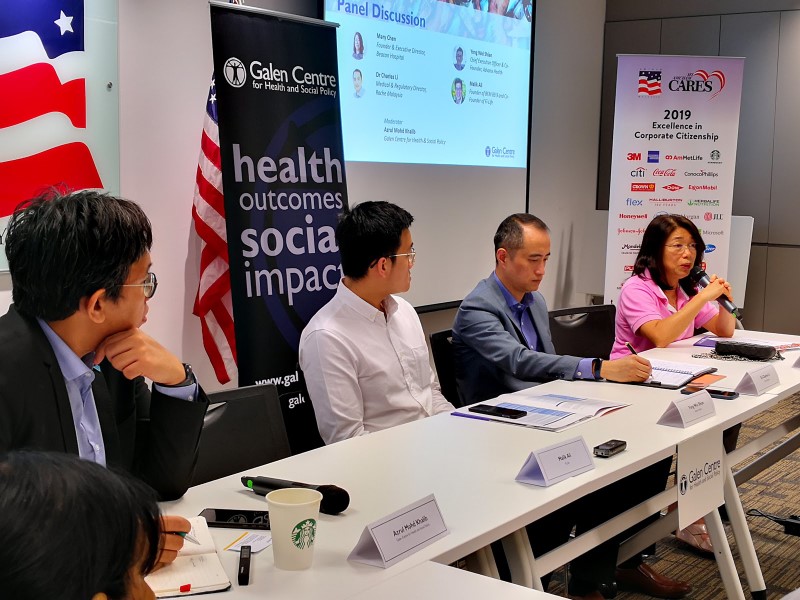KUALA LUMPUR, Jan 16 — For some private hospitals, running at a loss may be expected. But for Beacon Hospital, it lost over RM100 million to provide affordable cancer treatment.
This is because the hospital, according to its executive director, Mary Chen, wants to provide health care access, particularly cancer treatment, to all Malaysians — especially those who can’t afford it.
“I just use my love — I got a lot of love — to go all out (for) the patient because the patient, besides the treatment, they really need love,” Chen said.
“(The patients need someone) to talk with them… sit down (with) them, give them support, (and) let them know (that) lots of things can happen, a lot of things (have) advanced, (there are) better machines, and medicine will be better and better — to give them hope.
“(Then) they will start (thinking) they have a future.”
Chen was speaking at the CEO Roundtable on Cancer event at the American Malaysian Chamber of Commerce here last November that was hosted by the Galen Centre for Health and Social Policy.
Originally known as Wijaya International Medical Centre, the hospital was renamed Beacon after Chen took over the Petaling Jaya hospital in November 2010 at a price tag of RM20 million — a rebranding that is only apt.
A beacon shines light for ships in the darkness of the night. And for a hospital that gives almost free cancer treatment for patients who need it, the analogy of a beacon giving light and hope in the absence of it, makes all the more sense.
Chen decided to take over Beacon after realising that most people seeking treatment sell off their assets and end up in debt only so they can prolong their lives for a few more years. At the time, her personal business was doing well, and her children were already grown up. So, she decided to buy over the hospital.
However, when she took over Beacon, the hospital had already lost RM60 million. And for the next nine years, the hospital lost millions more, she said.
“This nine-year journey (has) not (been) easy. We lost (a) hundred million, this hospital; it already lost (a) hundred million (and it) continues (to lose) a hundred million.
“But luckily, last year, we are picking up. Break even already,” said the primary school leaver from Semenyih in Selangor.
“We never ask a single cent from outside for donation,” she added.
In the early days of Beacon, Chen and her team frequented Sabah and Sarawak to bring them to Selangor to get treatment and free consultations. There were not that many oncologists in East Malaysia at the time, she said.
There, she went to the markets and factories, armed with placards, and told them if they had no money, they could come to Beacon and they would help.
“’Beacon can help you if you have cancer. Please come to us’,” she recalled saying, waving her hands frantically with an imaginary placard, and drawing laughter from the room.
Chen also recalled sending “spies” to the National Cancer Institute in Putrajaya to encourage young cancer patients to seek treatment at Beacon instead.
But only time will tell if Beacon’s model is a sustainable one. Medicine is expensive, chemotherapy drugs especially, which saw Chen withdrawing all her Employees’ Provident Fund (EPF) savings when she was 55 to pump cash into Beacon.
Radiotherapy treatment, on the other hand, ranges from RM20,000 to RM40,000 in some private hospitals.
At Beacon though, the goal is to offer treatment from as low as zero, though those who are able to foot some portion of the costs are encouraged to do so.
“We hope these patients, (at least) half of them can pay between RM20,000 and RM40,000,” she said. “Our maximum charge is RM20,000.
“So, the ones who cannot afford to pay, even if they have RM5,000 or RM500 or zero, we still continue to treat.”
She also made reference to the monoclonal antibody drug that is used to treat breast cancer, saying patients at Beacon only pay up to RM2,500 maximum; it is RM9,000 or RM10,00 at other private hospitals, according to Chen.
“We help already more than (a) hundred patients (who have been with) us. It’s 18 cycles. One cycle is already RM10,000. The patient pays RM2,500 and the drug company charge us a bit low, so we pay (for) everything.
“(But), I can help only until this limit.”
Some of Beacon’s strategies to cut down costs to ensure that all patients are able to seek treatment include halving the prices of drugs that it supplies to private hospitals, and then asking that they lower the cost of their PET-CT scans by the same percentage.
Beacon plans to open up another hospital in the East Coast.









